Ram Cargo Van 2012 Owners Manual
Manufacturer: RAM, Model Year: 2012, Model line: Cargo Van, Model: Ram Cargo Van 2012Pages: 642, PDF Size: 9.7 MB
Page 91 of 642
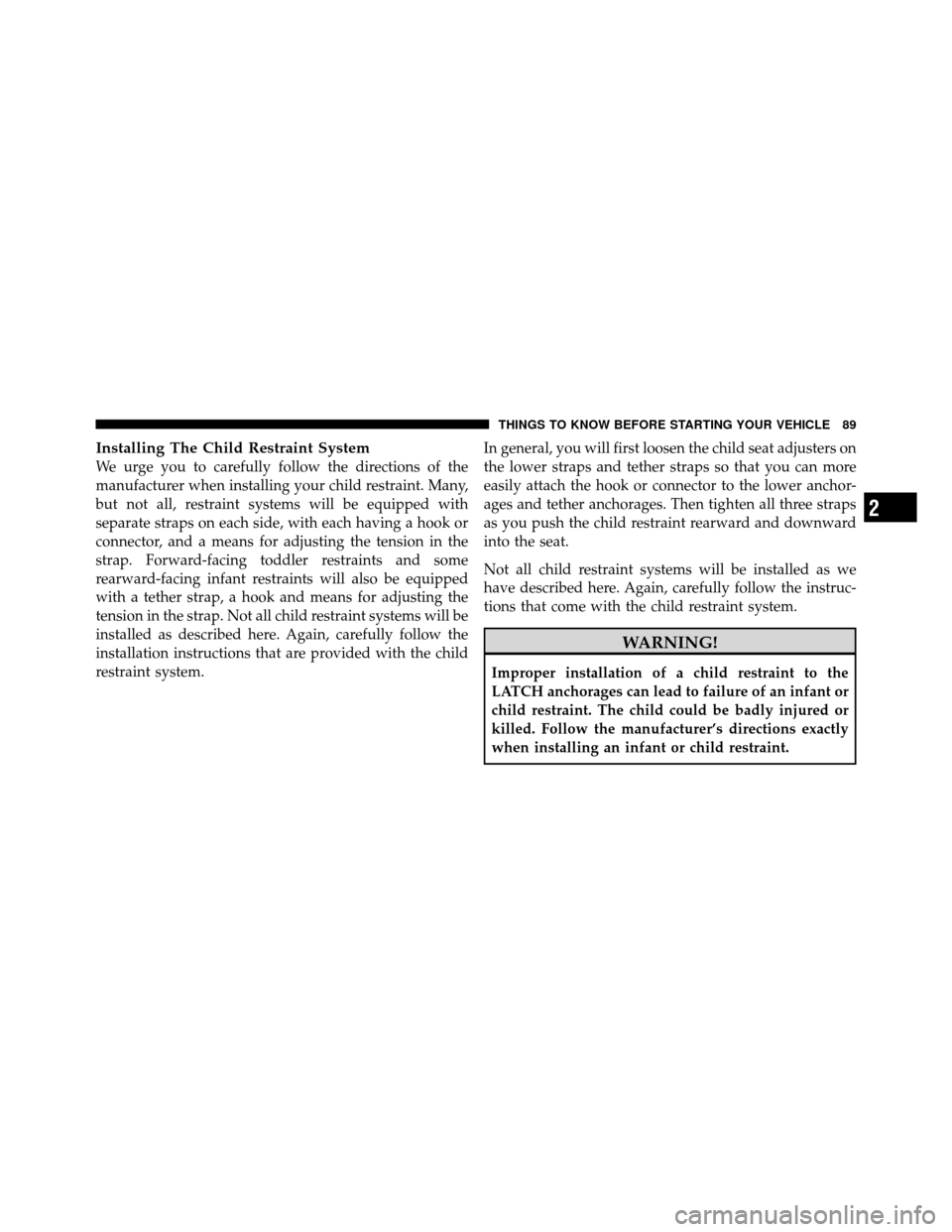
Installing The Child Restraint System
We urge you to carefully follow the directions of the
manufacturer when installing your child restraint. Many,
but not all, restraint systems will be equipped with
separate straps on each side, with each having a hook or
connector, and a means for adjusting the tension in the
strap. Forward-facing toddler restraints and some
rearward-facing infant restraints will also be equipped
with a tether strap, a hook and means for adjusting the
tension in the strap. Not all child restraint systems will be
installed as described here. Again, carefully follow the
installation instructions that are provided with the child
restraint system.In general, you will first loosen the child seat adjusters on
the lower straps and tether straps so that you can more
easily attach the hook or connector to the lower anchor-
ages and tether anchorages. Then tighten all three straps
as you push the child restraint rearward and downward
into the seat.
Not all child restraint systems will be installed as we
have described here. Again, carefully follow the instruc-
tions that come with the child restraint system.
WARNING!
Improper installation of a child restraint to the
LATCH anchorages can lead to failure of an infant or
child restraint. The child could be badly injured or
killed. Follow the manufacturer’s directions exactly
when installing an infant or child restraint.
2
THINGS TO KNOW BEFORE STARTING YOUR VEHICLE 89
Page 92 of 642
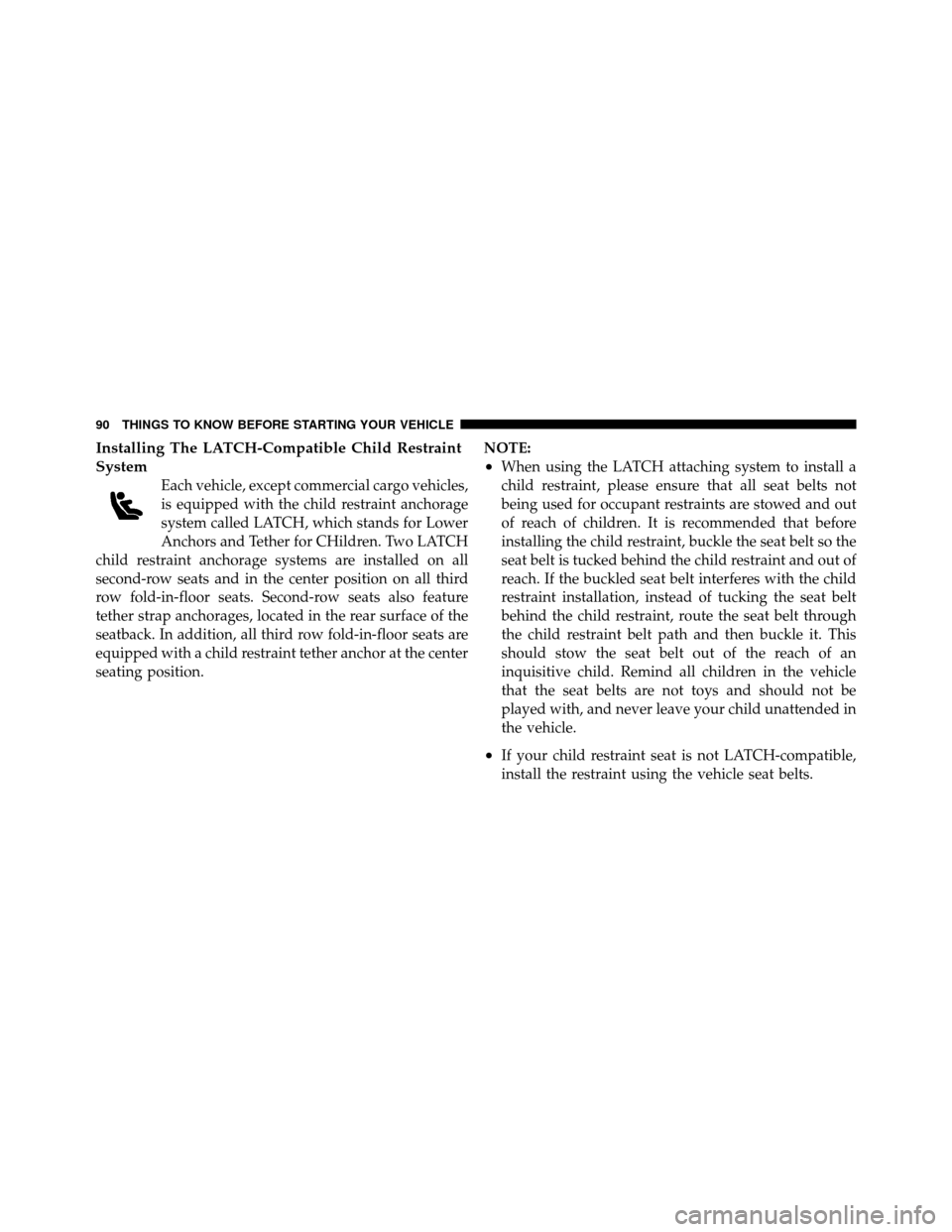
Installing The LATCH-Compatible Child Restraint
System
Each vehicle, except commercial cargo vehicles,
is equipped with the child restraint anchorage
system called LATCH, which stands for Lower
Anchors and Tether for CHildren. Two LATCH
child restraint anchorage systems are installed on all
second-row seats and in the center position on all third
row fold-in-floor seats. Second-row seats also feature
tether strap anchorages, located in the rear surface of the
seatback. In addition, all third row fold-in-floor seats are
equipped with a child restraint tether anchor at the center
seating position. NOTE:
•When using the LATCH attaching system to install a
child restraint, please ensure that all seat belts not
being used for occupant restraints are stowed and out
of reach of children. It is recommended that before
installing the child restraint, buckle the seat belt so the
seat belt is tucked behind the child restraint and out of
reach. If the buckled seat belt interferes with the child
restraint installation, instead of tucking the seat belt
behind the child restraint, route the seat belt through
the child restraint belt path and then buckle it. This
should stow the seat belt out of the reach of an
inquisitive child. Remind all children in the vehicle
that the seat belts are not toys and should not be
played with, and never leave your child unattended in
the vehicle.
•If your child restraint seat is not LATCH-compatible,
install the restraint using the vehicle seat belts.
90 THINGS TO KNOW BEFORE STARTING YOUR VEHICLE
Page 93 of 642
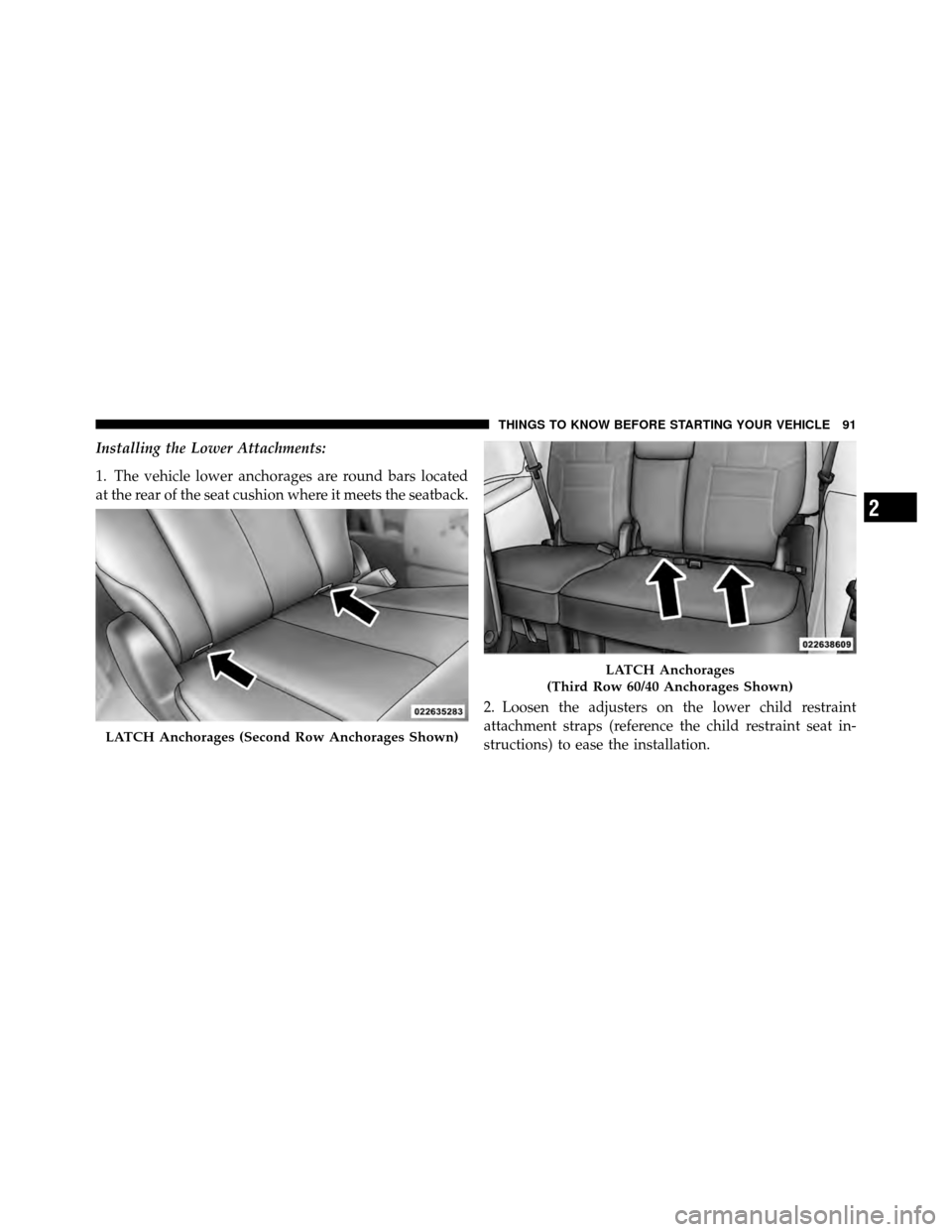
Installing the Lower Attachments:
1. The vehicle lower anchorages are round bars located
at the rear of the seat cushion where it meets the seatback.2. Loosen the adjusters on the lower child restraint
attachment straps (reference the child restraint seat in-
structions) to ease the installation.
LATCH Anchorages (Second Row Anchorages Shown)
LATCH Anchorages
(Third Row 60/40 Anchorages Shown)
2
THINGS TO KNOW BEFORE STARTING YOUR VEHICLE 91
Page 94 of 642
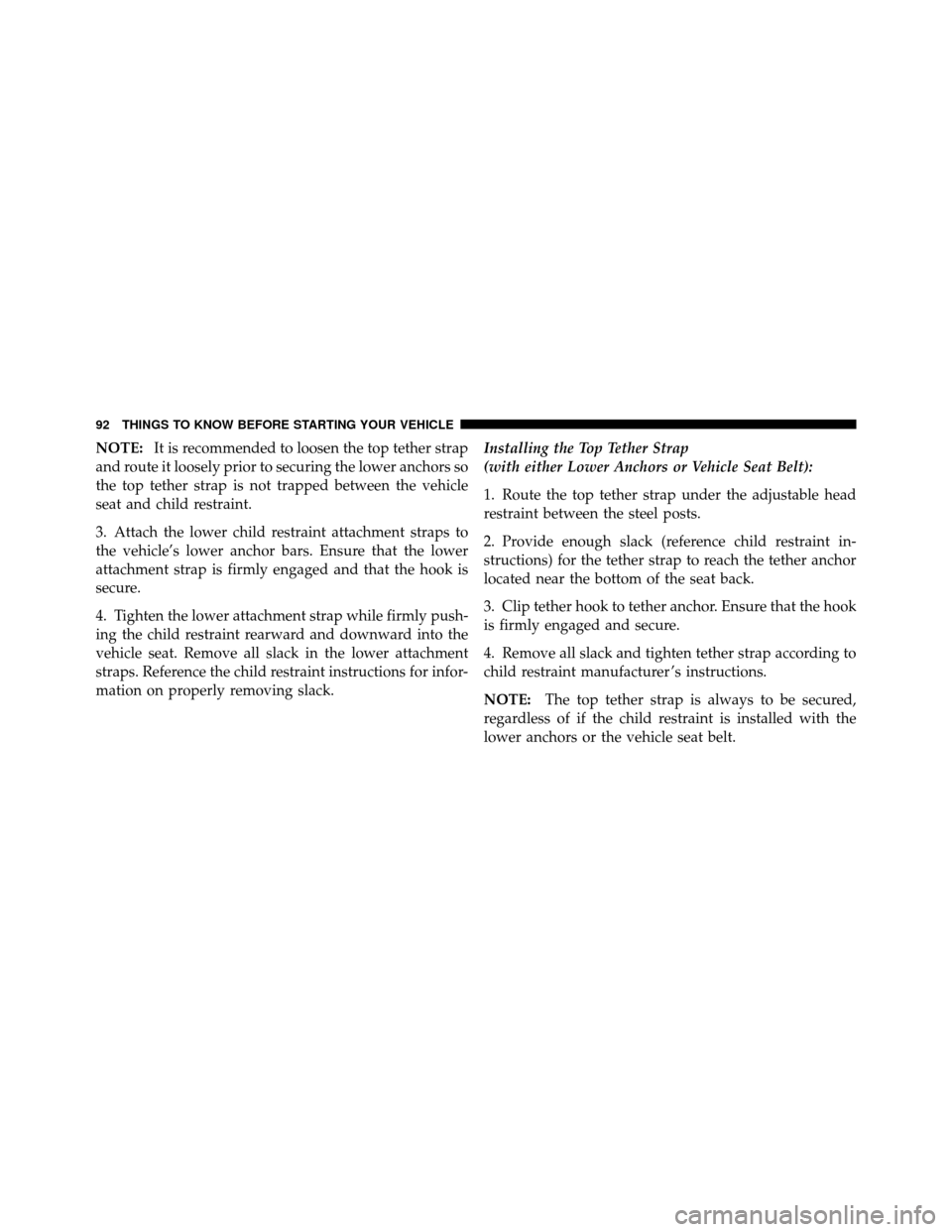
NOTE:It is recommended to loosen the top tether strap
and route it loosely prior to securing the lower anchors so
the top tether strap is not trapped between the vehicle
seat and child restraint.
3. Attach the lower child restraint attachment straps to
the vehicle’s lower anchor bars. Ensure that the lower
attachment strap is firmly engaged and that the hook is
secure.
4. Tighten the lower attachment strap while firmly push-
ing the child restraint rearward and downward into the
vehicle seat. Remove all slack in the lower attachment
straps. Reference the child restraint instructions for infor-
mation on properly removing slack. Installing the Top Tether Strap
(with either Lower Anchors or Vehicle Seat Belt):
1. Route the top tether strap under the adjustable head
restraint between the steel posts.
2. Provide enough slack (reference child restraint in-
structions) for the tether strap to reach the tether anchor
located near the bottom of the seat back.
3. Clip tether hook to tether anchor. Ensure that the hook
is firmly engaged and secure.
4. Remove all slack and tighten tether strap according to
child restraint manufacturer ’s instructions.
NOTE:
The top tether strap is always to be secured,
regardless of if the child restraint is installed with the
lower anchors or the vehicle seat belt.
92 THINGS TO KNOW BEFORE STARTING YOUR VEHICLE
Page 95 of 642
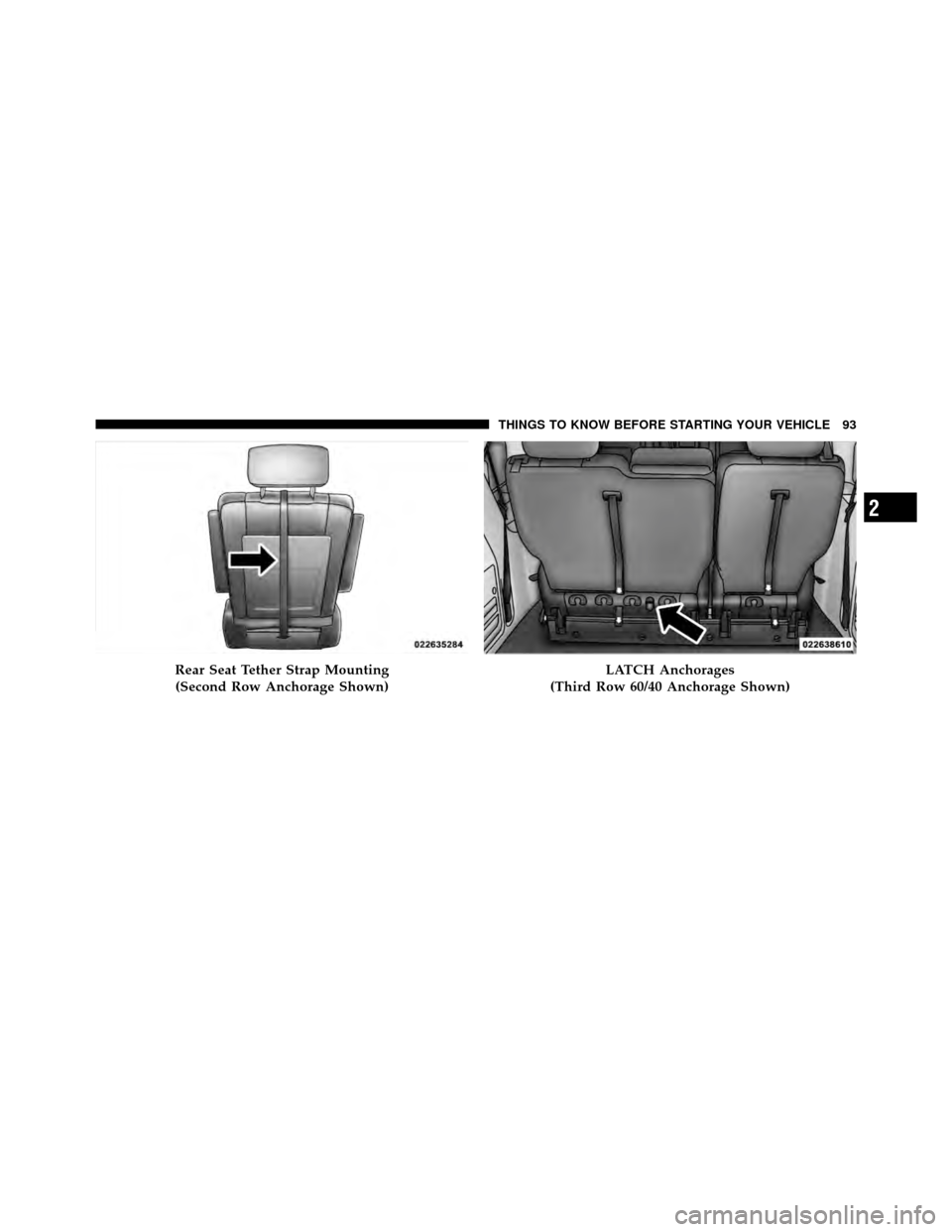
Rear Seat Tether Strap Mounting(Second Row Anchorage Shown)LATCH Anchorages
(Third Row 60/40 Anchorage Shown)
2
THINGS TO KNOW BEFORE STARTING YOUR VEHICLE 93
Page 96 of 642
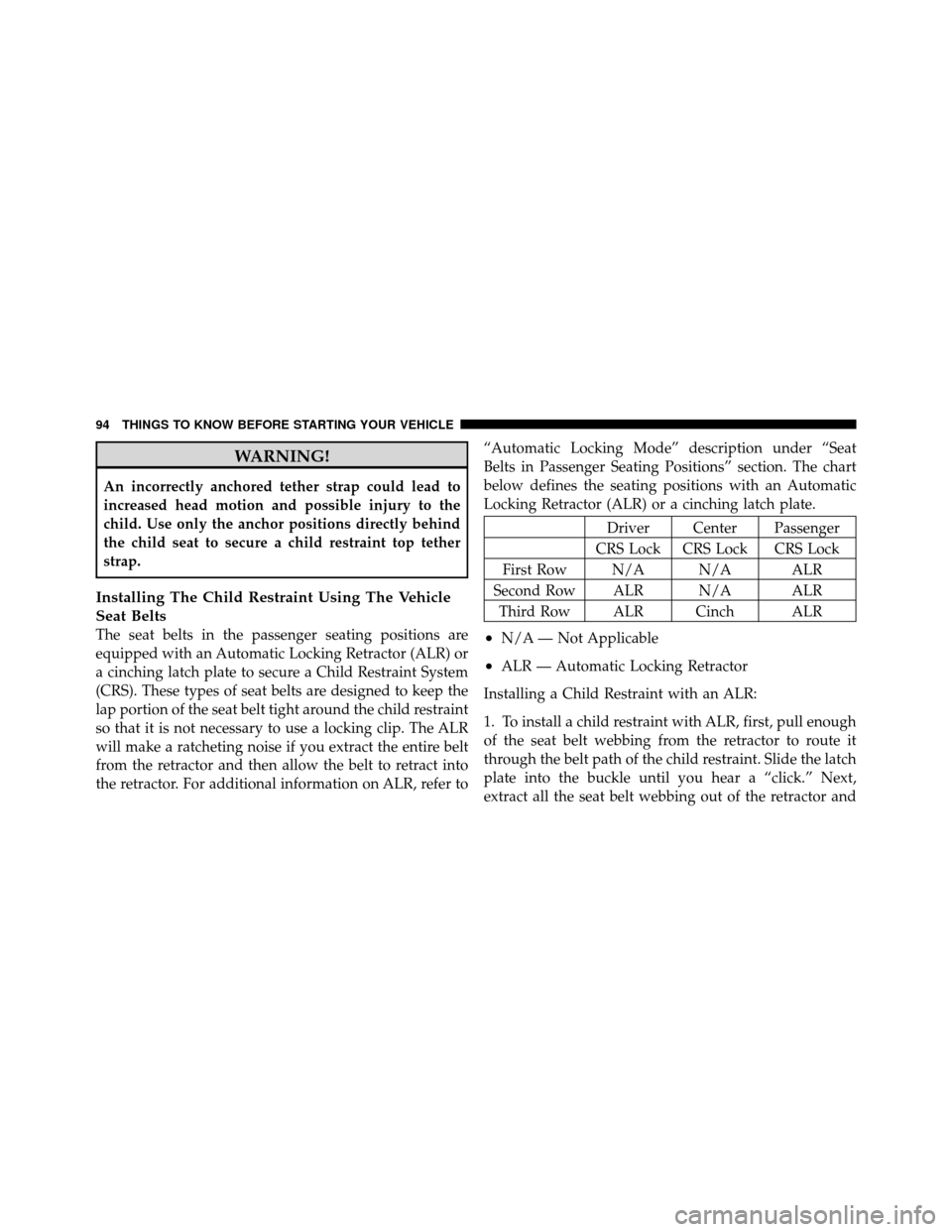
WARNING!
An incorrectly anchored tether strap could lead to
increased head motion and possible injury to the
child. Use only the anchor positions directly behind
the child seat to secure a child restraint top tether
strap.
Installing The Child Restraint Using The Vehicle
Seat Belts
The seat belts in the passenger seating positions are
equipped with an Automatic Locking Retractor (ALR) or
a cinching latch plate to secure a Child Restraint System
(CRS). These types of seat belts are designed to keep the
lap portion of the seat belt tight around the child restraint
so that it is not necessary to use a locking clip. The ALR
will make a ratcheting noise if you extract the entire belt
from the retractor and then allow the belt to retract into
the retractor. For additional information on ALR, refer to“Automatic Locking Mode” description under “Seat
Belts in Passenger Seating Positions” section. The chart
below defines the seating positions with an Automatic
Locking Retractor (ALR) or a cinching latch plate.
Driver Center Passenger
CRS Lock CRS Lock CRS Lock
First Row N/A N/A ALR
Second Row ALR N/A ALR Third Row ALR Cinch ALR
•N/A — Not Applicable
•ALR — Automatic Locking Retractor
Installing a Child Restraint with an ALR:
1. To install a child restraint with ALR, first, pull enough
of the seat belt webbing from the retractor to route it
through the belt path of the child restraint. Slide the latch
plate into the buckle until you hear a “click.” Next,
extract all the seat belt webbing out of the retractor and
94 THINGS TO KNOW BEFORE STARTING YOUR VEHICLE
Page 97 of 642
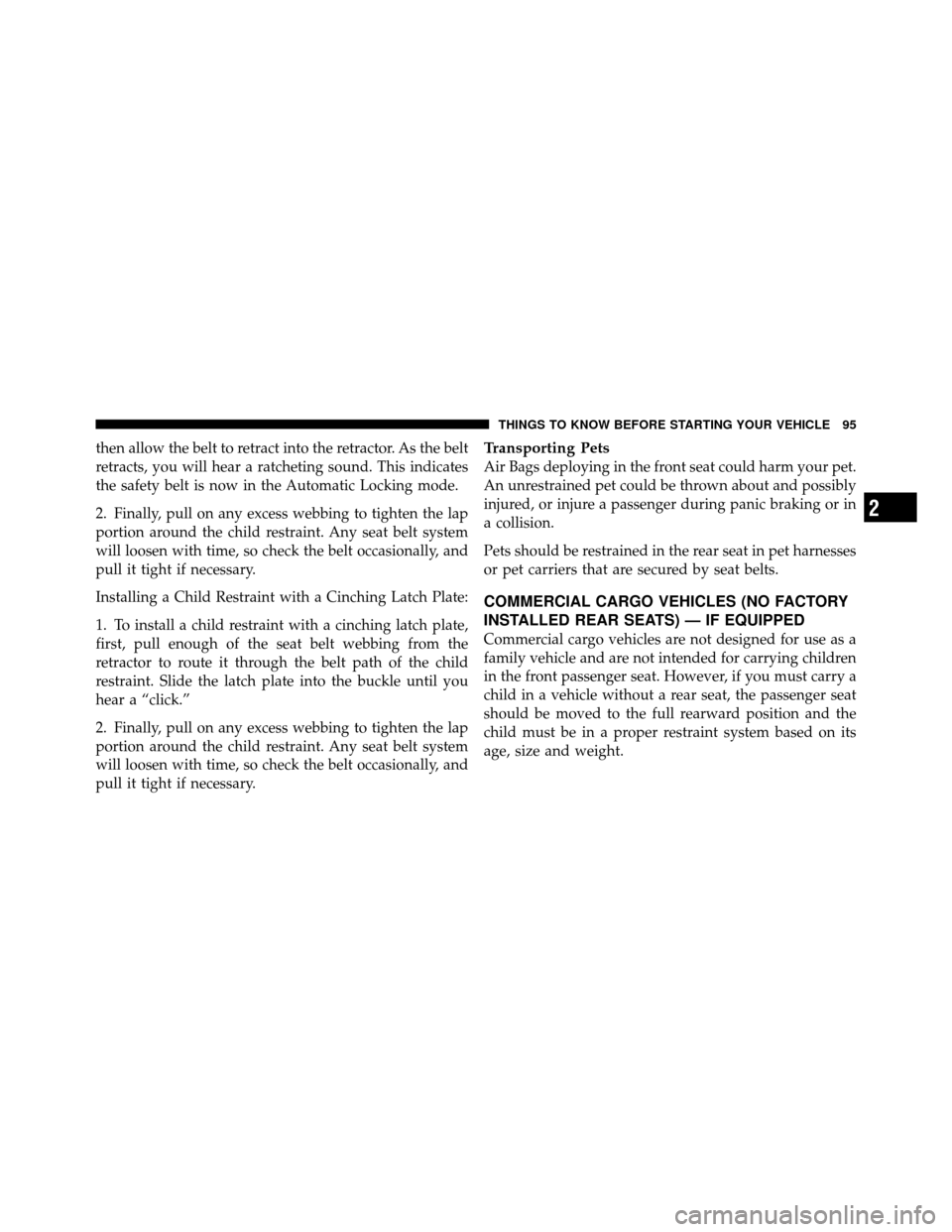
then allow the belt to retract into the retractor. As the belt
retracts, you will hear a ratcheting sound. This indicates
the safety belt is now in the Automatic Locking mode.
2. Finally, pull on any excess webbing to tighten the lap
portion around the child restraint. Any seat belt system
will loosen with time, so check the belt occasionally, and
pull it tight if necessary.
Installing a Child Restraint with a Cinching Latch Plate:
1. To install a child restraint with a cinching latch plate,
first, pull enough of the seat belt webbing from the
retractor to route it through the belt path of the child
restraint. Slide the latch plate into the buckle until you
hear a “click.”
2. Finally, pull on any excess webbing to tighten the lap
portion around the child restraint. Any seat belt system
will loosen with time, so check the belt occasionally, and
pull it tight if necessary.Transporting Pets
Air Bags deploying in the front seat could harm your pet.
An unrestrained pet could be thrown about and possibly
injured, or injure a passenger during panic braking or in
a collision.
Pets should be restrained in the rear seat in pet harnesses
or pet carriers that are secured by seat belts.
COMMERCIAL CARGO VEHICLES (NO FACTORY
INSTALLED REAR SEATS) — IF EQUIPPED
Commercial cargo vehicles are not designed for use as a
family vehicle and are not intended for carrying children
in the front passenger seat. However, if you must carry a
child in a vehicle without a rear seat, the passenger seat
should be moved to the full rearward position and the
child must be in a proper restraint system based on its
age, size and weight.
2
THINGS TO KNOW BEFORE STARTING YOUR VEHICLE 95
Page 98 of 642
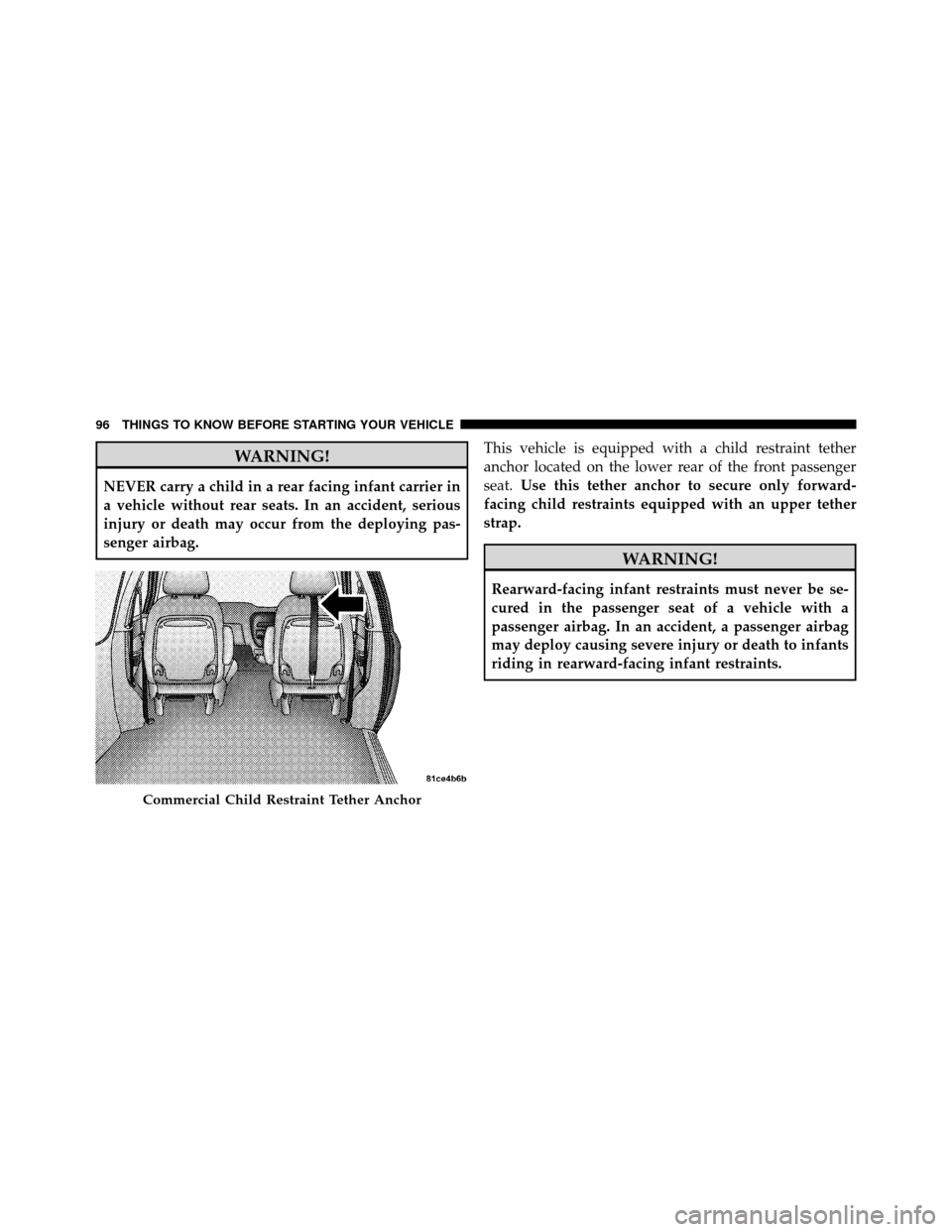
WARNING!
NEVER carry a child in a rear facing infant carrier in
a vehicle without rear seats. In an accident, serious
injury or death may occur from the deploying pas-
senger airbag.This vehicle is equipped with a child restraint tether
anchor located on the lower rear of the front passenger
seat.
Use this tether anchor to secure only forward-
facing child restraints equipped with an upper tether
strap.
WARNING!
Rearward-facing infant restraints must never be se-
cured in the passenger seat of a vehicle with a
passenger airbag. In an accident, a passenger airbag
may deploy causing severe injury or death to infants
riding in rearward-facing infant restraints.
Commercial Child Restraint Tether Anchor
96 THINGS TO KNOW BEFORE STARTING YOUR VEHICLE
Page 99 of 642
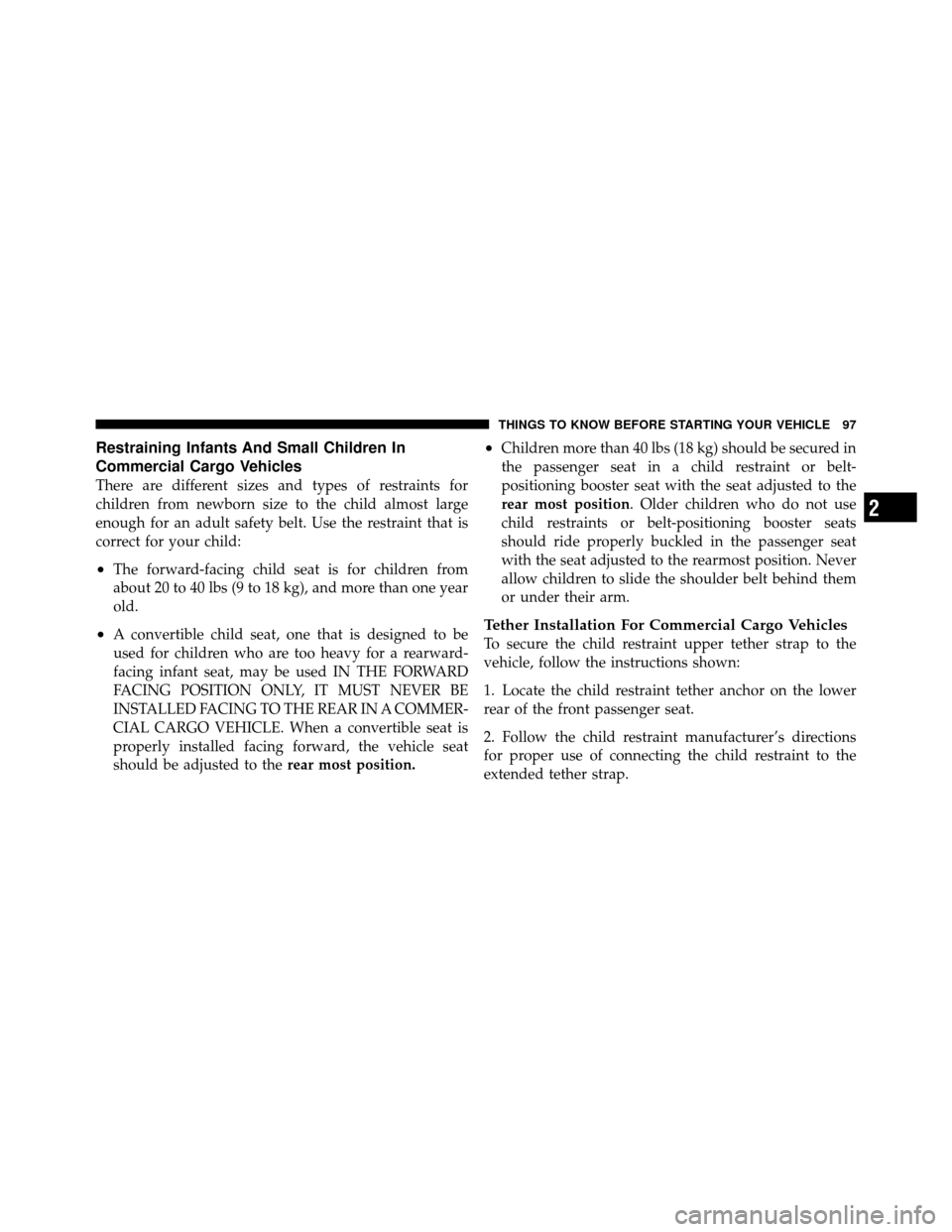
Restraining Infants And Small Children In
Commercial Cargo Vehicles
There are different sizes and types of restraints for
children from newborn size to the child almost large
enough for an adult safety belt. Use the restraint that is
correct for your child:
•The forward-facing child seat is for children from
about 20 to 40 lbs (9 to 18 kg), and more than one year
old.
•A convertible child seat, one that is designed to be
used for children who are too heavy for a rearward-
facing infant seat, may be used IN THE FORWARD
FACING POSITION ONLY, IT MUST NEVER BE
INSTALLED FACING TO THE REAR IN A COMMER-
CIAL CARGO VEHICLE. When a convertible seat is
properly installed facing forward, the vehicle seat
should be adjusted to therear most position.
•Children more than 40 lbs (18 kg) should be secured in
the passenger seat in a child restraint or belt-
positioning booster seat with the seat adjusted to the
rear most position. Older children who do not use
child restraints or belt-positioning booster seats
should ride properly buckled in the passenger seat
with the seat adjusted to the rearmost position. Never
allow children to slide the shoulder belt behind them
or under their arm.
Tether Installation For Commercial Cargo Vehicles
To secure the child restraint upper tether strap to the
vehicle, follow the instructions shown:
1. Locate the child restraint tether anchor on the lower
rear of the front passenger seat.
2. Follow the child restraint manufacturer’s directions
for proper use of connecting the child restraint to the
extended tether strap.
2
THINGS TO KNOW BEFORE STARTING YOUR VEHICLE 97
Page 100 of 642
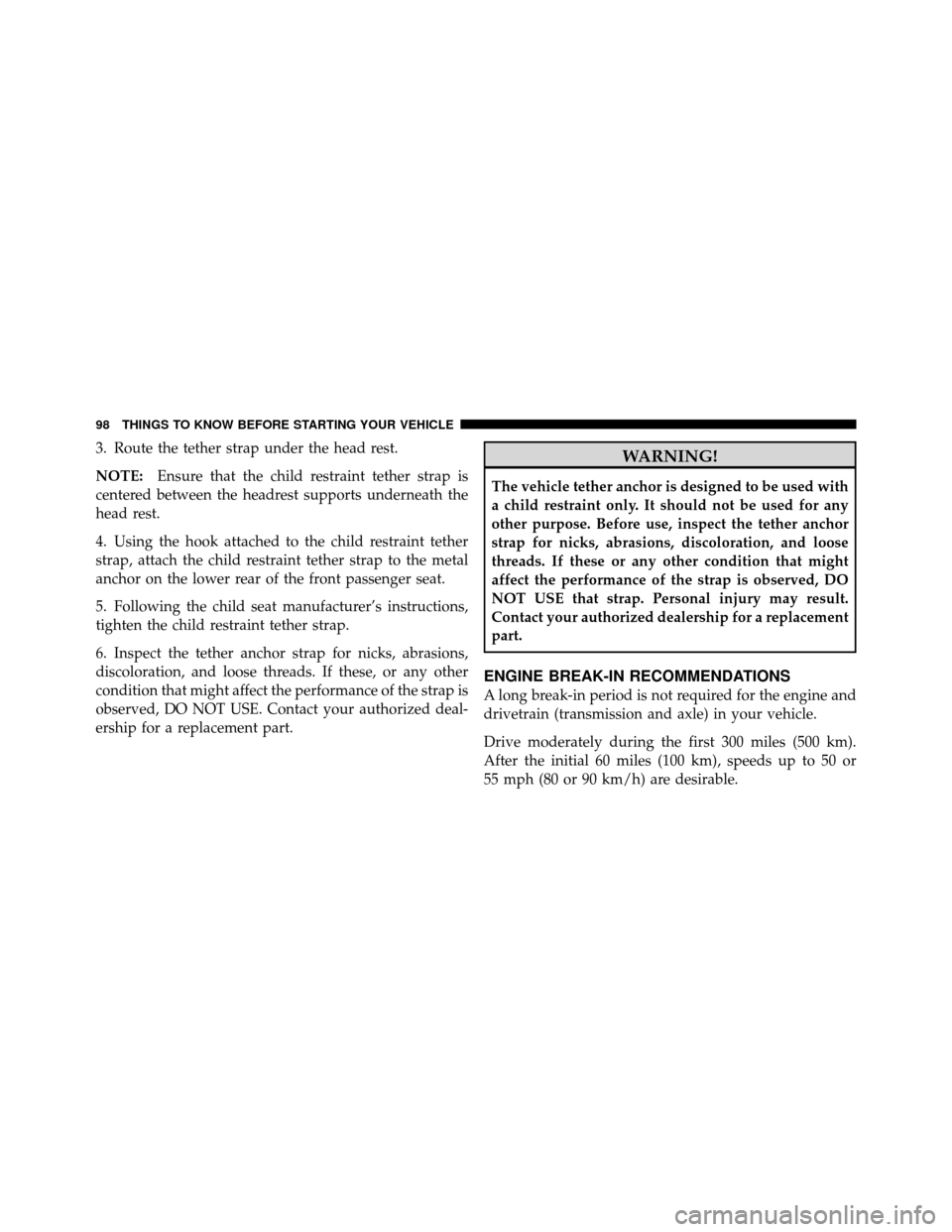
3. Route the tether strap under the head rest.
NOTE:Ensure that the child restraint tether strap is
centered between the headrest supports underneath the
head rest.
4. Using the hook attached to the child restraint tether
strap, attach the child restraint tether strap to the metal
anchor on the lower rear of the front passenger seat.
5. Following the child seat manufacturer’s instructions,
tighten the child restraint tether strap.
6. Inspect the tether anchor strap for nicks, abrasions,
discoloration, and loose threads. If these, or any other
condition that might affect the performance of the strap is
observed, DO NOT USE. Contact your authorized deal-
ership for a replacement part.WARNING!
The vehicle tether anchor is designed to be used with
a child restraint only. It should not be used for any
other purpose. Before use, inspect the tether anchor
strap for nicks, abrasions, discoloration, and loose
threads. If these or any other condition that might
affect the performance of the strap is observed, DO
NOT USE that strap. Personal injury may result.
Contact your authorized dealership for a replacement
part.
ENGINE BREAK-IN RECOMMENDATIONS
A long break-in period is not required for the engine and
drivetrain (transmission and axle) in your vehicle.
Drive moderately during the first 300 miles (500 km).
After the initial 60 miles (100 km), speeds up to 50 or
55 mph (80 or 90 km/h) are desirable.
98 THINGS TO KNOW BEFORE STARTING YOUR VEHICLE